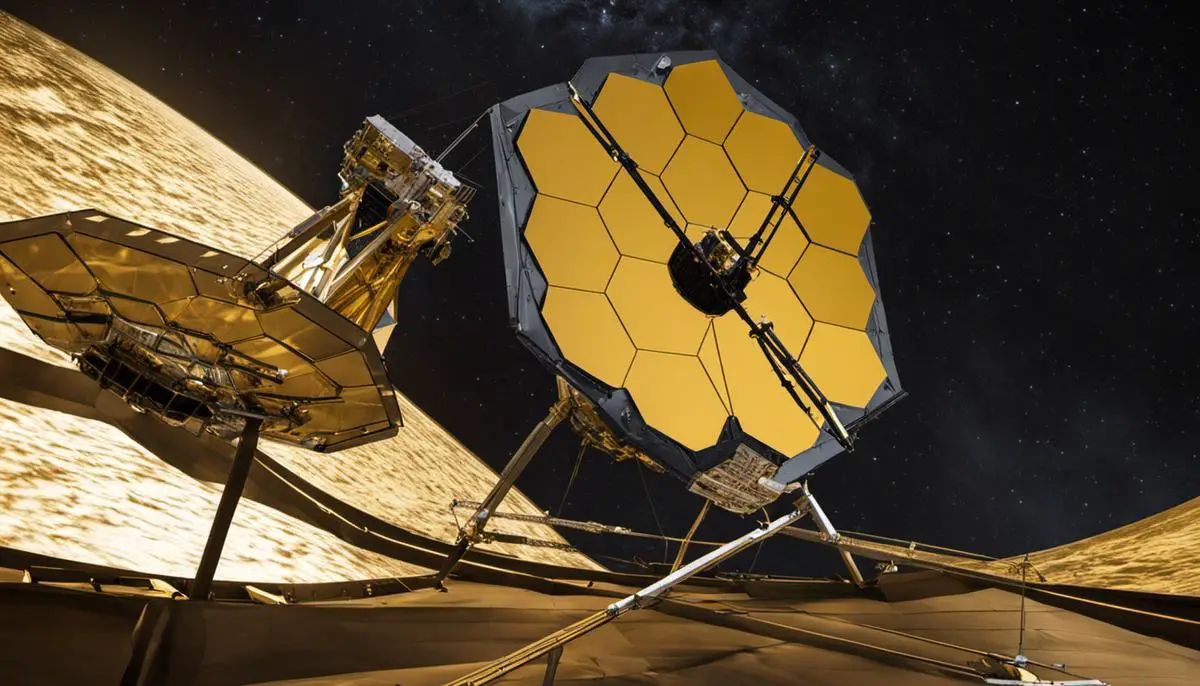Advancing our astronomical exploration to new dimensions, the James Webb Space Telescope stands at the precipice of a new era in space science. This advanced machinery surpasses its predecessor, the Hubble Telescope, introducing innovative technology that marks it as a significant addition to our astronomical tools. The telescope’s unique design and capabilities make it ideally equipped to enhance our observations of cosmic phenomena. This includes an in-depth study of exoplanets – planets beyond our solar system. Our understanding of these distant worlds has significantly grown due to advancements in detection methods such as transit and radial velocity, further aided by the discovery of several exoplanets. As we strive to find planets within the ‘habitable zone’ attached with potential signs of life, much depends on our leap forwards in technological proficiency.
The James Webb Space Telescope: An Overview
Development and launch of the James Webb Space Telescope.
The James Webb Space Telescope (JWST), named after the former NASA administrator, represents the pinnacle of modern astrophysical engineering. Its development, which spanned over two decades, was a collaborative effort involving NASA, the European Space Agency, and the Canadian Space Agency. The JWST was launched from French Guiana on board an Ariane 5 rocket on December 25, 2021, following several delays and budget overruns.
An Advanced Technological Marvel: The JWST as a Successor to the Hubble Telescope
To appreciate JWST’s significance, a comparison to its predecessor, the Hubble Space Telescope, is vital. The Hubble Space Telescope revolutionized the field of astrophysics but was limited in its infrared capabilities, a key wavelength range for examining distant astronomical phenomena like exoplanets. This is where the JWST comes into play; it can observe the universe in far greater detail using its more advanced technology. Equipped with a gigantic mirror of 6.5 meters in diameter (compared to Hubble’s 2.4 meters), a specially designed sunshield to block sunlight and keep the instruments cool, and a suite of ultra-sensitive infrared instruments, the JWST marks a substantial leap in space telescope technology.
Mission Objectives: Zooming in on Exoplanets
One of the most exciting aspects of JWST’s mission is the detailed study of exoplanets – planets orbiting stars outside our solar system. Its instruments, particularly the Near Infrared Camera (NIRCam) and Near InfraRed Spectrograph (NIRSpec), will allow scientists to look through the atmospheric gas of exoplanets, identifying key atmospheric components such as water vapor, carbon dioxide, and possibly even signs of biological activity. Situated at the Sun-Earth L2 Lagrange point, a gravitationally stable location in space, the JWST will be cooled below -220 degrees Celsius, allowing it to detect the tiny amount of heat given off by these distant, often temperate, planets.
The Unique Design: Enhancing Observations of Astronomical Phenomena
The design of the JWST allows it to transcend the observational limitations of its predecessors. Unlike other telescopes that remain fixed in Earth’s orbit, JWST will orbit the sun, a million miles away from Earth. This enables it to receive unobstructed views of the universe. Additionally, its beryllium-coated primary mirror will collect light from the distant universe with seven times Hubble’s light gathering capacity. Furthermore, the sunshield, which is about the size of a tennis court, will act as a parasol, protecting the telescope from solar heating and light, which can interfere with infrared observations, thereby facilitating detailed observations of dim astronomical phenomena, like distant exoplanets.
Advancements and Enhancements Offered by the James Webb Space Telescope
The James Webb Space Telescope (JWST) offers numerous advantages over its predecessor, the Hubble Space Telescope. It is designed to last for a minimum of 10 years, which is a substantial improvement compared to the Hubble’s initially planned 15 years, which has barely been extended by servicing missions. Furthermore, JWST’s location at the Sun-Earth L2 point significantly reduces fuel usage, increasing the telescope’s expected lifespan. Another key feature of the JWST is its enhanced infrared capabilities, which offer greater precision and resolution. These advancements will be particularly beneficial for the detection and characterization of exoplanets. Consequently, the JWST is expected to illuminate us on many mysterious and fascinating aspects of the universe, specifically exoplanets, leading towards a prolonged understanding of the cosmos.
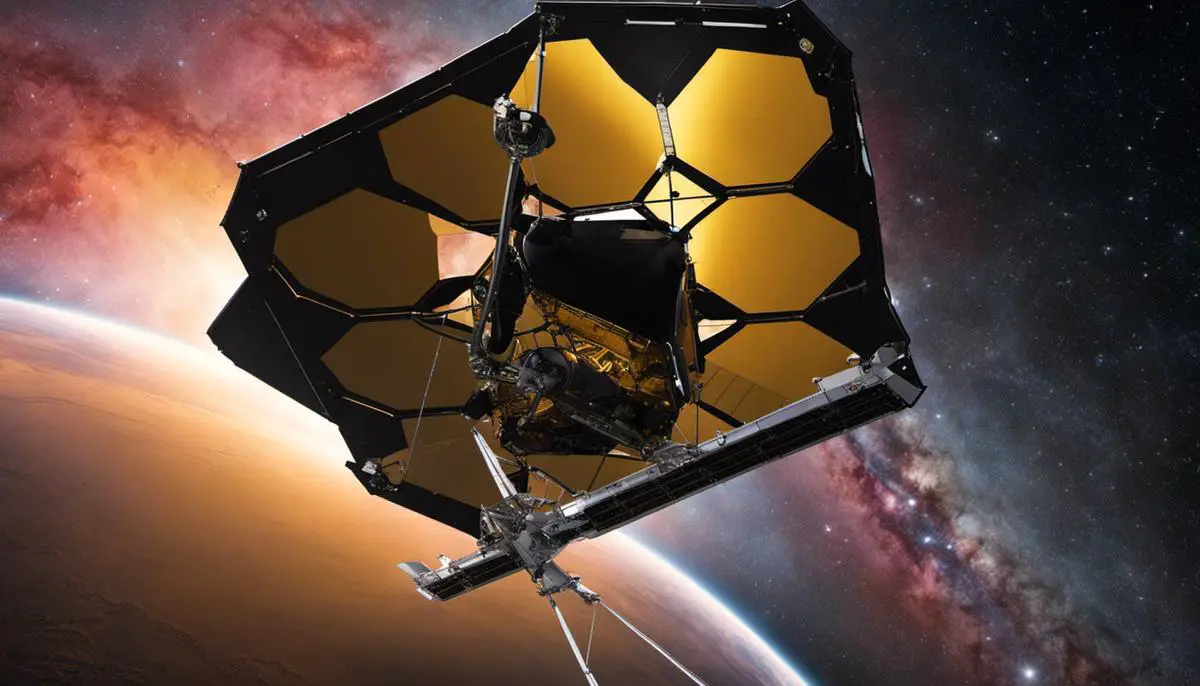
Exoplanets: What We Know So Far
Exploring the Mysterious Exoplanets
Exoplanets, also referred to as extrasolar planets, are planets orbiting stars beyond our solar system. These exoplanets provide a wide array of diversity, showing characteristics largely distinct from those within our solar system. For instance, while some exoplanets complete their orbits around their star in just a few days, others display orbits that resemble our own Earth. These intriguing varieties of exoplanets are eagerly being observed, and the enhanced capabilities of the JWST will significantly contribute to these studies.
Methods of Detecting Exoplanets
Detecting exoplanets is a challenging task due to their small size relative to their host stars and the vast distances separating them from us. Among the most commonly used methods are transit and radial velocity.
The transit method is based on the observation of a star’s brightness. When a planet passes in front of its star, it blocks a small amount of the star’s light, causing a small dip in brightness that can be detected by telescopes.
The radial velocity method, on the other hand, relies on the gravitational effect of the planet on its host star. As a planet orbits, it causes the star to wobble around the center of mass, resulting in a shift in the star’s spectral lines that can be identified using high-precision spectrometers.
Significant Discoveries of Exoplanets
To date, astronomers have confirmed the existence of over 4,000 exoplanets. Some of the most significant discoveries were planets in the TRAPPIST-1 system. Located about 40 light-years away, this system contains seven rocky, Earth-size planets, three of which orbit in their star’s habitable zone.
Habitable Zone and Its Importance
The ‘habitable zone’ is the region around a star where conditions might be right to support liquid water—an essential ingredient for life as we know it. A planet situated in the habitable zone of its star receives roughly the right amount of energy to maintain liquid water on its surface, given adequate atmospheric pressure. Hence, finding planets in this zone is considered significant, as they have the most potential to harbor extraterrestrial life.
Exploring the Cosmos with James Webb: A Focus on Exoplanets
Set to launch in 2021, the James Webb Space Telescope (JWST) aims to significantly enhance our understanding of exoplanets. This remarkable tool is equipped with an impressive array of instruments to thoroughly analyze the atmospheres of these remote celestial bodies in search of potential signs of life. These include markers such as water vapor, oxygen, and chemical imbalances that might indicate biological activities. The JWST will also focus on the planets in the TRAPPIST-1 system, particularly those found within the habitable zone, paving the way for profound insights into these intriguing distant worlds.
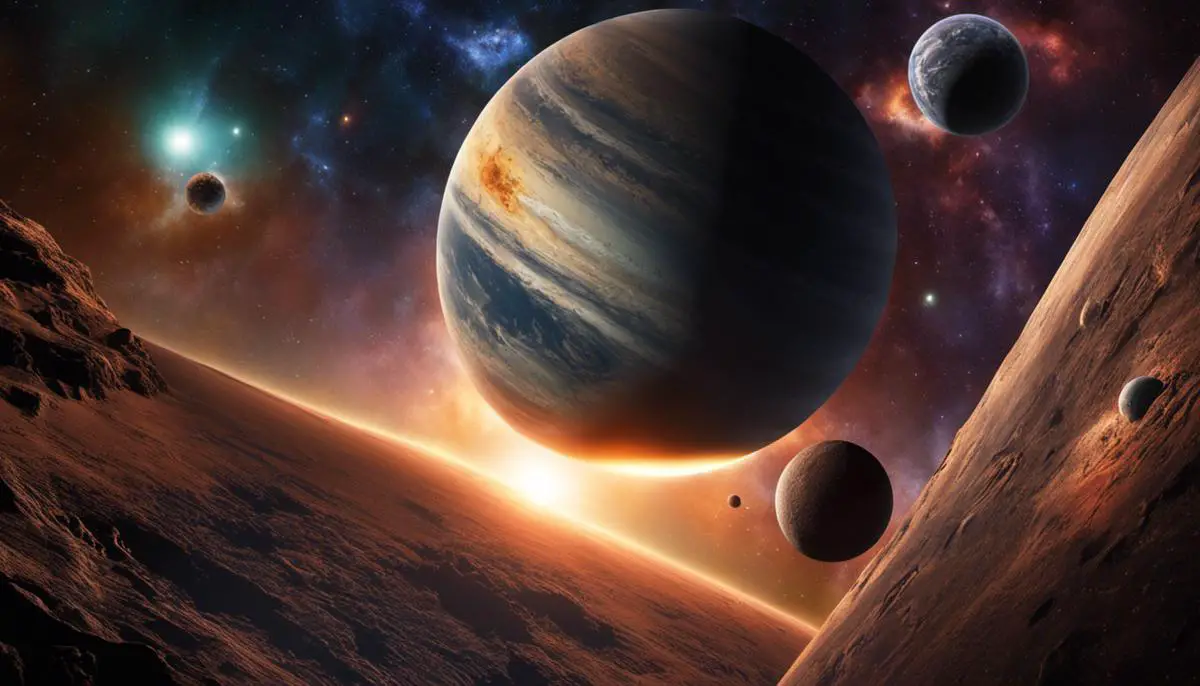
The Role of James Webb in Studying Exoplanets
The Power and Capabilities of the James Webb Space Telescope
Undeniably, the JWST is a much more potent device than its predecessor, the Hubble Space Telescope. It boasts a larger mirror, a raft of sophisticated instruments, and groundbreaking technology. While one of its core objectives is to observe distant galaxies at the farthest corners of the universe, the JWST’s capability isn’t limited to such grand scope. It also has a keen focus on offering a deeper understanding of local celestial bodies, with exoplanets being its particular area of interest.
Dwarfing Hubble’s mirror, the JWST’s enormous mirror is almost three times larger, which makes it capable of collecting substantially more light. Such an upgrade significantly assists in the detection of faint signals emanating from the distant exoplanets. Furthermore, the telescope’s instruments provide a longer wavelength coverage and greater precision. These advances make the direct study of exoplanets’ atmospheres a reality.
Revolutionizing the Study of Exoplanets
JWST’s advanced technology redefines the horizon of exoplanet research. Using a method known as transit spectroscopy, the telescope will observe the situations when an exoplanet passes in front of its host star—an event known as transit. During this transit, a fraction of starlight filters through the atmosphere of the exoplanet, carrying the signatures of its atmosphere’s chemical composition.
These spectral lines are akin to an exoplanet’s chemical fingerprint and hold secrets about the planet’s atmospheric structure, temperature, and elemental distribution. JWST, with its noteworthy sensitivity, can then analyze the spectral data carefully to find clues about the atmosphere and potential signs of habitability such as the presence of water vapor.
Detecting Planetary Atmospheres and Understanding Chemical Compositions
The powerful JWST will have the ability to study the atmospheric makeup of exoplanets across a wide array of sizes, from the largest gas giants to rocky, Earth-sized ones. It aims to uncover what the atmospheres of these foreign planets are made of, including a definite focus on the detection of the “biosignature gases” such as oxygen, methane, carbon dioxide, and nitrogen.
Attempting to understand a planet’s atmosphere provides significant insights into the conditions on the surface of the planet. For instance, an atmosphere rich in greenhouse gases may imply a hot, potentially inhospitable, surface environment. Furthermore, unveiling the secrets of exoplanet atmospheres can present unique and exciting discoveries about the chemical cycles and processes occurring on these planets.
Conclusion
In conclusion, the James Webb Space Telescope (JWST) is set to significantly enhance our understanding of exoplanets. Through its use of transit spectroscopy, the JWST can closely examine the chemical makeup of these celestial bodies beyond our solar system, potentially transforming our current comprehension of exoplanets and unveiling indications of alien life.
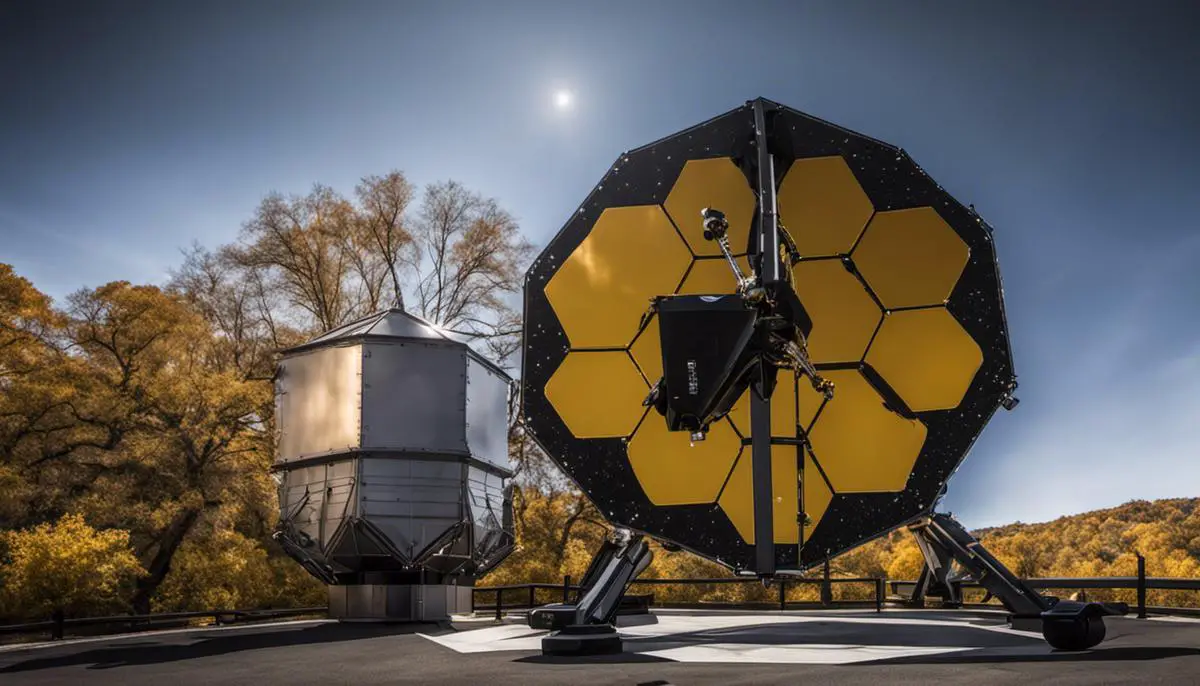
Potential Discoveries with James Webb Telescope
Exploration of Exoplanets through the James Webb Space Telescope
The James Webb Space Telescope, touted as the next successor to the renowned Hubble Telescope, has its sights set on reforming our understanding of exoplanets- otherworldly planets that orbit stars exterior to our solar system. This state-of-the-art telescope boasts cutting-edge imaging and spectrograph capabilities that will assist in detecting and characterizing these remote planets, ultimately extending our understanding of the cosmos.
Examining Exoplanets Atmospheres for Potential Signs of Life
One of the areas that the James Webb Telescope will explore is the search for potential signs of life on exoplanets. This will be achieved primarily by using a technique called spectroscopy – analyzing the light from these planets to identify the atoms and molecules present. By doing so, it is hoped that this new telescope will identify biosignatures or chemical signs of life, such as oxygen, carbon dioxide, and methane in the atmospheres of these exoplanets. Finding these biosignatures could be a game-changing discovery, pointing towards the existence of extraterrestrial life.
The Climates of Exoplanets: A New Frontier in Space Science
Beyond merely identifying signs of life, James Webb will also provide insights into the climate conditions of these far-off planets. With its advanced technology, the telescope can measure the chemical composition of an exoplanet’s atmosphere and deduce its weather patterns, temperature, and even the color of its skies and sunsets. Such knowledge could yield vital clues about the habitability of these celestial bodies.
James Webb Telescope’s contribution to Astrobiology
The new discoveries about exoplanets and their possible habitability that James Webb might bring hold significant implications for the field of astrobiology. Astrobiology is reliant on understanding the potential environments that could support life, and thus, information about the atmospheres and climates of exoplanets is vital. These insights could help astrobiologists explain how life started, and perhaps even help predict where it might exist elsewhere in the universe.
Introduction to the Role of the James Webb Space Telescope in Understanding our Universe
For humanity, the study of exoplanets by the James Webb Space Telescope signifies a bold leap in expanding our cosmic understanding. Unveiling the existence of potential life signs on these remote celestial bodies could profoundly alter our perception of our place in the cosmos, stirring interesting dialogues about our own beginnings. Added to this, the scientific information diligently aggregated by the telescope could influence several other scientific disciplines intertwined with our knowledge of the cosmos – physics, chemistry, and environmental science. This resource of knowledge could even drop subtle hints at the prospect of future space exploration or colonization. Such undertakings depict the significance of this mission, not solely for the scientific community, but essentially for all humankind.
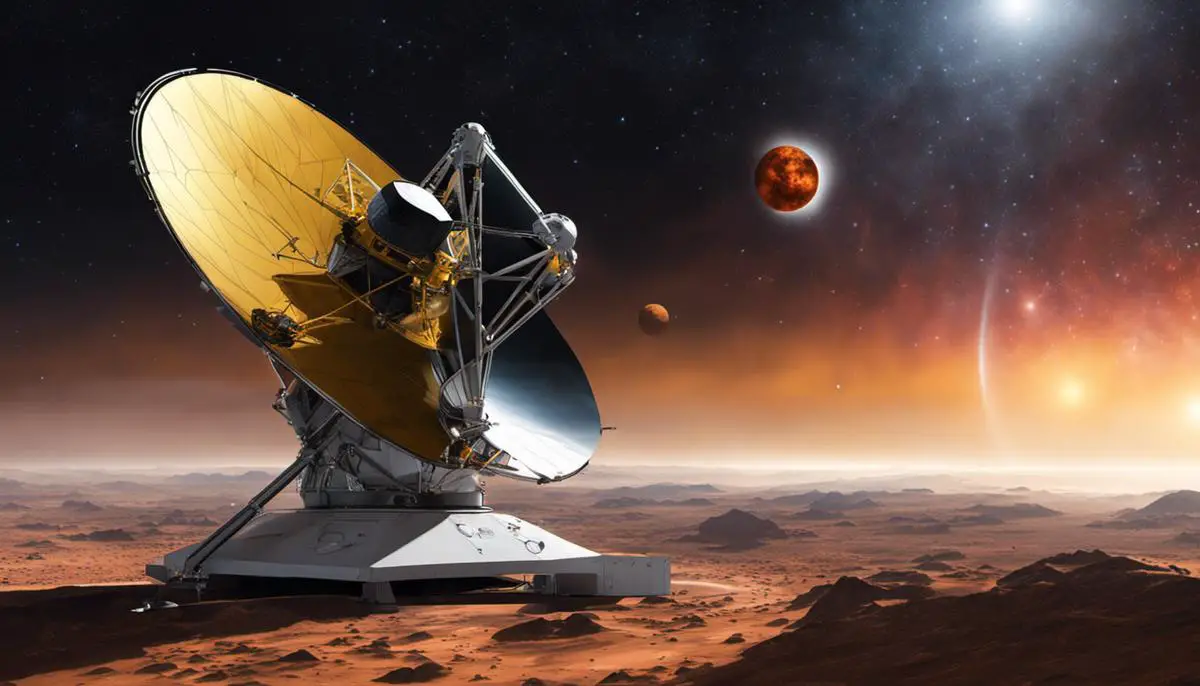
Limitations and Challenges of Exoplanet Study
Adventures and Challenges in Exoplanet Observation
Investigating exoplanets- the planets orbiting stars beyond our home solar system- represents a daunting and intricately multifaceted venture. A significant barrier resides in the overwhelming distances between Earth and these celestial entities, housed light-years away. The enormity of this cosmic distance restricts astronomers to mere distant observations, barring them from making meaningful physical contact with exoplanets.
Furthermore, the tools currently employed for this colossal task, even the applauded James Webb Space Telescope (JWST), bear their own restrictions in terms of sensitivity and detailed resolution. Extracting discerning and consequential details from such expansive ranges is a momentous challenge. And like all technologies, there remain ample opportunities for refinement and further development, including the concurrent evolution in our approach to data analysis derived from these observations.
Limitations in Technology and Observing Techniques
Our exploration of exoplanets primarily takes place through Indirect methods, such as Doppler Spectroscopy and Transit Photometry. The methods entail observing the effects of a planet on its host star, either through subtle shifts in light or apparent dimming when the planet transits across the star’s path. While these techniques have made the discovery of thousands of exoplanets possible, they also have their limitations and drawbacks.
Most notably, these methods struggle to detect small planets that are far from their host stars, as their effects are subtle and difficult to observe. Therefore, we might be overlooking many planetary systems that don’t meet our current criteria for detection.
Examining Exoplanets with JWST
James Webb’s forthcoming endeavor to observe and explore distant exoplanets promises to provide us with more detailed images and data than ever before. The telescope is equipped with highly sensitive infrared detectors that can penetrate dust and gas clouds to view the heat radiation from planets and other celestial objects.
However, despite JWST’s groundbreaking technology, there still exist major challenges. For instance, given that the majority of exoplaneted studied will be done through transiting studies. This means the exoplanet must pass directly between its star and the telescope – an event that doesn’t occur for all exoplanets. Thus, a huge section of exoplanets may remain difficult to examine.
Constraints of Current Exoplanet Information
Further, our understanding is also restricted by the quality of the data our current observing techniques provide. The data often consist of indirect measurements or inferences – rarely do we obtain direct information about the planets’ characteristics. Typically, we infer the size, mass, and the possible composition of an exoplanet, but we seldom have clear information about the exoplanetary atmospheres, surfaces or possible conditions for life.
Inferences about Exoplanets with JWST
To compound this, the information that JWST will obtain about the majority of exoplanets will primarily be inferences of their atmospheres. These inferences will be made by examining the starlight filtering through an exoplanet’s atmosphere during its transit. There are two limitations to this method, one is the assumption that the starlight has interacted with the atmosphere, and two, it doesn’t provide insights about the planetary surfaces.
In conclusion
Although James Webb Space Telescope’s examination of exoplanets will be a giant leap forward, there remain many challenges and limitations in our pursuit to understand these distant worlds. As technology and observing techniques continue to develop, we may slowly begin to unlock more of the universe’s secrets. But, understanding exoplanets comprehensively will be a journey spanning many generations.

Despite the endless possibilities and potential discoveries that studying exoplanets brings, the journey is not without its challenges. The complex nature of exoplanetary science is fraught with various limitations, from the constraints of currently available technology to the great distances of these alien worlds from Earth. These factors can significantly hinder our understanding and interpretation of the information gathered. Yet, the promise of uncovering new frontiers in astrobiology and stepping closer to answering the age-old question “Are we alone in the universe?” underscores the importance of this journey. As we set our sights on the cosmos with the James Webb Space Telescope, we ready ourselves for the profound discoveries and revelations waiting to be illuminated from the dark stretches of the universe.
![]()
